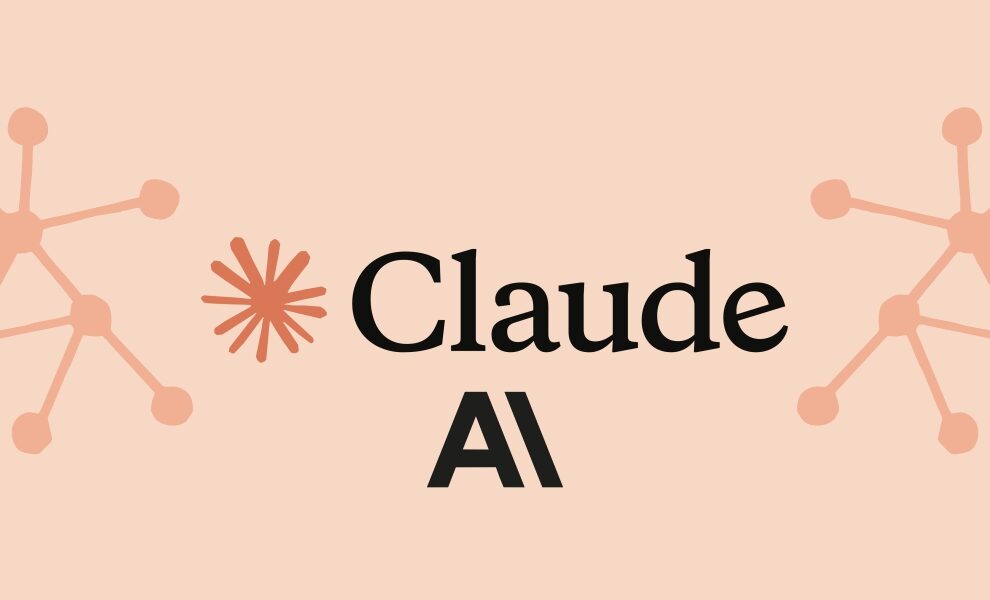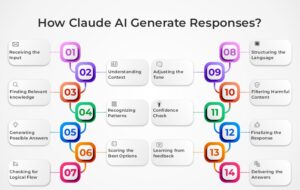Artificial intelligence has changed the way we engage with technology, and Claude AI is a concept that is leading this revolution. At the same time, conventional search engines are retrieving pre- stored answers. This AI understands the reasons and generates responses in real-time. But how does it work? What happens while answering those instant, human-like responses?
The secret lies in a powerful 14-step process backed by millions of parameters. Well, nothing but the mathematical connections that help this AI learn, analyze, and respond intelligently.
Let’s understand how this advanced AI model processes and provides easy interactions in this blog.
What Exactly is Claude AI?
Claude AI is an advanced artificial intelligence assistant designed by the AI leader, Anthropic to understand and respond to human questions conversationally. Unlike basic chatbots that follow scripted answers or search engines that just retrieve web links, this AI actually:
- Understand the meaning of your questions.
- Connects different concepts logically.
- Generates original answers instead of copying text.
- Adapts its responses based on context.
It also helps with research, writing, coding, problem-solving, and general knowledge. This makes it useful for students, professionals, and curious minds.
The Foundation: Training on Massive Data
Before Claude AI could answer questions; it had to learn from massive volumes of text-based data, such as books, articles, research, and others. During this learning phase, it is able to understand language patterns, context, and even variations such as sarcasm and humor. The AI doesn’t just memorize facts; it learns how to organize thoughts, assume word sequences, and create coherent responses.
The 14 Steps Process: How Claude AI Thinks Through Questions
When you ask this AI a question, it doesn’t just guess the answer. Instead, it follows a detailed 14-step thinking process:
- Receiving the Input
First, Claude AI takes your question and prepares it for analysis. This means checking for clarity and identifying the main subject. - Understanding Context
The AI looks at your words carefully to grasp what you are really asking. It considers the topic (whether it is related to science, history, or some other), the type of answer you need (short facts or detailed explanation), and any hidden meaning in your question. - Finding Relevant knowledge
Claude AI searches through its vast training data (books, articles, and other reliable sources it learned from) to find information related to your question. - Recognizing Patterns
Using its training, the AI notices how words and ideas connect. For example, if you ask about “the causes of World War 2,” it knows to look for political, economic, and historical factors. - Generating Possible Answers
At this stage, this AI comes up with several potential responses based on what it found. - Scoring the Best Options
Not all possible answers are equally good. The AI ranks them by accuracy, relevance, and usefulness. - Checking for Logical Flow
The system ensures the answer makes sense from start to finish, without contradictions. - Structuring the Language
This AI arranges the words naturally, like how a human would speak or write. - Adjusting the Tone
Depending on the question, the AI might respond formally, casually, or even humorously. - Filtering Harmful Content
Before answering, this AI checks if the response could be biased, offensive, or dangerous and fixes it if needed. - Confidence Check
The AI evaluates how sure it is about the answer. If uncertain, it might say no instead of guessing. - Finalizing the Response
The best version of the answer is prepared for delivery. - Learning from feedback
If users correct their answers, this AI model will remember these improvements for the next time. - Delivering the Answers
Finally, you get a clear, well-structured response in seconds.
This entire process happens almost instantly because of its powerful computing capabilities.
Millions of Parameters: The “Brain” Behind Claude AI
The 14-step process is guided by something called AI parameters— the real “brain” of the system.
What are AI parameters?
Parameters are like tiny switches in Claude AI’s “brain” that help it:
- Recognize word meanings.
- Understand how sentences connect.
- Decide which responses make the most sense.
Imagine teaching a child language:
- First, they learn simple words (like “cat” or “run”).
- Then, they understand how words form sentences (“The cat runs fast”).
- Finally, they learn when different responses are appropriate.
Its parameters work similarly but on a massive scale.
Why More Parameters Make AI Smarter
Early AI systems had just thousands of parameters, enough for basic tasks. This AI has millions or even billions, allowing it to:
- Handle complex questions with multiple layers.
- Understand subtle differences in meaning.
- Generate more natural, human-like responses.
More parameters mean the AI can make finer distinctions in language, leading to better answers.
How the 14 Steps and Parameters Work Together
The parameters act like Clae AI’s knowledge and instincts, while the 14-step process is how it applies that knowledge to your questions.
Example: If you ask, “Why is the sky grey?”
1. The parameters help AI:
- To understand “sky” and “grey” as related to light and atmosphere.
- Understand this is a science question needing a clear explanation.
2. The 14-step process then:
- Find the physics explanation for light scattering.
- Structures it into an easy-to-understand answer.
- Check that the explanation is accurate and appropriate.
Without enough parameters, the AI might give a vague or incorrect answer. Without step-by-step reasoning, it might state facts without making them understandable.
Why This Makes Claude AI Special?
Many AI tools either just retrieve information (like search engines) or generate text without deep understanding (like simple chatbots). This AI combines both capabilities:
- Deep understanding of millions of parameters.
- Careful reasoning through the 14-step process.
- Natural communication that feels human.
This is why it can:
- Explain complex topics simply.
- Adapt answers for different needs.
- Admit when it’s unsure instead of guessing.
Wrapping Up!
Claude AI is a new generation of artificial intelligence. One that doesn’t find information but truly understands and explains it. By combining a detailed 14-step reasoning process with millions of finely tuned parameters, it provides answers that are quick, precise, and quite human-like.
As more upgrades and developments are in process, this AI model will be able to assist with education, research, and general problem-solving even more effectively. This makes advanced knowledge more accessible to everyone.
To learn more about AI, visit HiTechNectar!
FAQs:
Q1: Is Claude AI always correct?
Answer: While highly accurate, this AI can sometimes make mistakes. Its 14-step process includes checking facts, but users should verify critical information.
Q2: How is Claude AI different from ChatGPT?
Answer: Both use similar technology, but this AI emphasizes clearer reasoning steps and safety checks in its responses.
Q3: Does Claude AI learn from my conversations?
Answer: It improves generally from feedback but doesn’t remember personal data between chats to protect privacy.
Recommended reads:
What Is a Generative Model? Unlocking The Future of Creative Machine Learning



